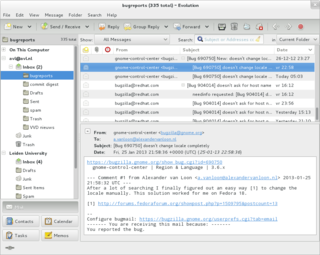
Electronic mail is a method of transmitting and receiving messages using electronic devices. It was conceived in the late–20th century as the digital version of, or counterpart to, mail. Email is a ubiquitous and very widely used communication medium; in current use, an email address is often treated as a basic and necessary part of many processes in business, commerce, government, education, entertainment, and other spheres of daily life in most countries.
Kerberos is a computer-network authentication protocol that works on the basis of tickets to allow nodes communicating over a non-secure network to prove their identity to one another in a secure manner. Its designers aimed it primarily at a client–server model, and it provides mutual authentication—both the user and the server verify each other's identity. Kerberos protocol messages are protected against eavesdropping and replay attacks.
Multipurpose Internet Mail Extensions (MIME) is an Internet standard that extends the format of email messages to support text in character sets other than ASCII, as well as attachments of audio, video, images, and application programs. Message bodies may consist of multiple parts, and header information may be specified in non-ASCII character sets. Email messages with MIME formatting are typically transmitted with standard protocols, such as the Simple Mail Transfer Protocol (SMTP), the Post Office Protocol (POP), and the Internet Message Access Protocol (IMAP).
Within the Internet email system, a message transfer agent (MTA), or mail transfer agent, or mail relay is software that transfers electronic mail messages from one computer to another using the Simple Mail Transfer Protocol. In some contexts the alternative names mail server, mail exchanger, and MX host can be used to describe an MTA.
In computing, the Post Office Protocol (POP) is an application-layer Internet standard protocol used by e-mail clients to retrieve e-mail from a mail server. Today, POP version 3 (POP3) is the most commonly used version. Together with IMAP, it is one of the most common protocols for email retrieval.
The Simple Mail Transfer Protocol (SMTP) is an Internet standard communication protocol for electronic mail transmission. Mail servers and other message transfer agents use SMTP to send and receive mail messages. User-level email clients typically use SMTP only for sending messages to a mail server for relaying, and typically submit outgoing email to the mail server on port 587 or 465 per RFC 8314. For retrieving messages, IMAP is standard, but proprietary servers also often implement proprietary protocols, e.g., Exchange ActiveSync.

An email client, email reader or, more formally, message user agent (MUA) or mail user agent is a computer program used to access and manage a user's email.
Mbox is a generic term for a family of related file formats used for holding collections of email messages. It was first implemented in Fifth Edition Unix.

Extensible Messaging and Presence Protocol is an open communication protocol designed for instant messaging (IM), presence information, and contact list maintenance. Based on XML, it enables the near-real-time exchange of structured data between two or more network entities. Designed to be extensible, the protocol offers a multitude of applications beyond traditional IM in the broader realm of message-oriented middleware, including signalling for VoIP, video, file transfer, gaming and other uses.
An email address identifies an email box to which messages are delivered. While early messaging systems used a variety of formats for addressing, today, email addresses follow a set of specific rules originally standardized by the Internet Engineering Task Force (IETF) in the 1980s, and updated by RFC 5322 and 6854. The term email address in this article refers to just the addr-spec in Section 3.4 of RFC 5322. The RFC defines address more broadly as either a mailbox or group. A mailbox value can be either a name-addr, which contains a display-name and addr-spec, or the more common addr-spec alone.
The Internet Calendaring and Scheduling Core Object Specification (iCalendar) is a media type which allows users to store and exchange calendaring and scheduling information such as events, to-dos, journal entries, and free/busy information, and together with its associated standards has been a cornerstone of the standardization and interoperability of digital calendars across different vendors. Files formatted according to the specification usually have an extension of .ics. With supporting software, such as an email reader or calendar application, recipients of an iCalendar data file can respond to the sender easily or counter-propose another meeting date/time. The file format is specified in a proposed Internet standard for calendar data exchange. The standard and file type are sometimes referred to as "iCal", which was the name of the Apple Inc. calendar program until 2012, which provides one of the implementations of the standard.
X.400 is a suite of ITU-T recommendations that define the ITU-T Message Handling System (MHS).
Message-oriented middleware (MOM) is software or hardware infrastructure supporting sending and receiving messages between distributed systems. MOM allows application modules to be distributed over heterogeneous platforms and reduces the complexity of developing applications that span multiple operating systems and network protocols. The middleware creates a distributed communications layer that insulates the application developer from the details of the various operating systems and network interfaces. APIs that extend across diverse platforms and networks are typically provided by MOM.
The MH Message Handling System is a free, open source e-mail client. It is different from almost all other mail reading systems in that, instead of a single program, it is made from several different programs which are designed to work from the command line provided by the shell on Unix-like operating systems. Another difference is that rather than storing multiple messages in a single file, messages each have their own separate file in a special directory. Taken together, these design choices mean that it is very easy and natural to script actions on mail messages using the normal shell scripting tools.
The Defense Message System or Defense Messaging System (DMS) is a deployment of secure electronic mail and directory services in the United States Department of Defense. DMS was intended to replace the AUTODIN network, and is based on implementations of the OSI X.400 mail, X.500 directory and X.509 public key certificates, with several extensions to meet the specific needs of military messaging.
The Automated Message Handling System (AMHS) is an automated message handling system that can be used to process, store, and disseminate legacy AUTODIN messages as well as Defense Message System (DMS) messages. The term "Automated Message Handling System" or "AMHS" has not been trademarked by a vendor, but is instead a product category that includes several systems and products created by government agencies, integrators and software companies. Examples include:
Variable envelope return path (VERP) is a technique used by some electronic mailing list software to enable automatic detection and removal of undeliverable e-mail addresses. It works by using a different return path for each recipient of a message.
A media type is a two-part identifier for file formats and format contents transmitted on the Internet. Their purpose is somewhat similar to file extensions in that they identify the intended data format. The Internet Assigned Numbers Authority (IANA) is the official authority for the standardization and publication of these classifications. Media types were originally defined in Request for Comments RFC 2045 (MIME) Part One: Format of Internet Message Bodies in November 1996 as a part of the MIME specification, for denoting type of email message content and attachments; hence the original name, MIME type. Media types are also used by other internet protocols such as HTTP and document file formats such as HTML, for similar purposes.
Boldon James is a UK-based software company incorporated in February 1985, and specialising in data classification and secure messaging solutions aimed primarily at the commercial, defence, intelligence and government marketplaces. The company is named after its founders Peter Boldon and Roger James. The company was acquired in June 2020 by Minneapolis, Minnesota-based software developer HelpSystems.

Nexor Limited is a privately held company based in Nottingham, providing products and services to safeguard government, defence and critical national infrastructure computer systems. It was originally known as X-Tel Services Limited.



